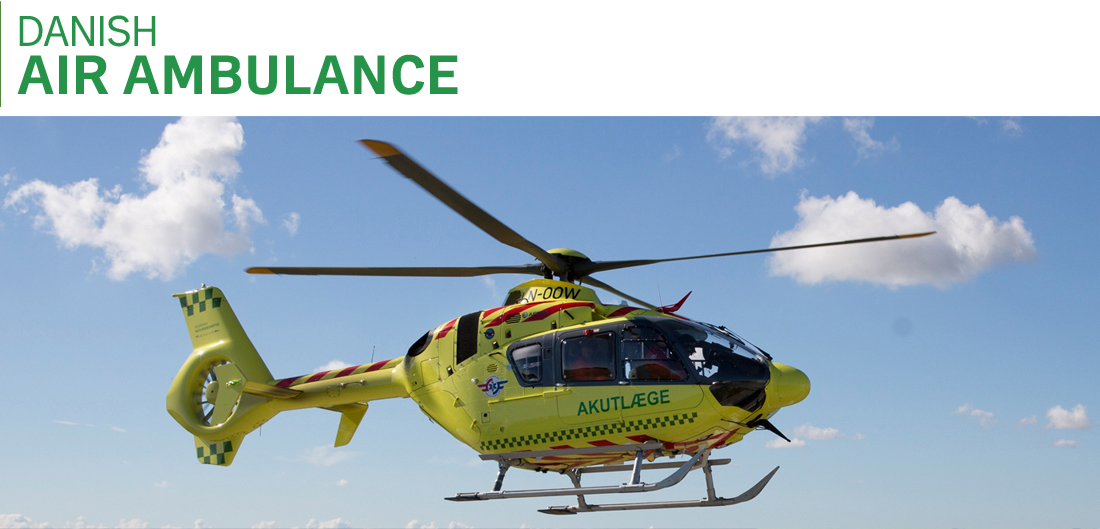The regions’ three emergency medical helicopters fly to an ever-increasing number of critically ill patients. 42% of patients who are flown directly to highly specialised treatment are cardiovascular patients. This is shown in a new annual report for the Helicopter Emergency Medical Service.
In a few years, the emergency medical helicopters have become an important part of the emergency medical assistance which is to help ensure equality in healthcare access. The helicopters take off when it is assessed medically that there is a need to bring highly specialised medical assistance on site quickly or if there is a time-related gain from flying the patient to a specialised hospital department instead of transporting the patient by road ambulance.
Cardiac arrest in fitness centre
This may, for example, be when a 1-1-2 emergency call is made with the message ‘Cardiac arrest in fitness centre’, as was the case on a Sunday in 2017, when Henning keeled over while training in his local fitness centre on Southern Zealand. The ambulance and acute medical car with a paramedic arrived quickly, and Henning was given life-saving assistance on site. But time was costly, and the emergency medical helicopter was therefore called, so that it could fly the patient to Rigshospitalet (Copenhagen University Hospital) for further examinations. It turned out that Henning had a narrowing of the arteries around his heart and needed surgery. The treatment has gone well, and Henning is today back in full training.
In the annual report, the emergency medical helicopter crew and other personnel who helped make a decisive difference for Henning describe the course of events. Henning himself does not remember anything: “I remember that I got onto the exercise bicycle. And after that I don’t remember anything.”
When time is vital
42% of the patients who are flown to examination and treatment at a specialised hospital department have cardiovascular disease. Henning is thus one of the 707 heart patients who received care from the air last year. Other large groups are patients with blood clot or brain haemorrhage symptoms and patients with severe injuries, for example after major traffic accidents.
“Patients throughout Denmark need rapid and specialised assistance,” says Chairman of Danish Regions, Stephanie Lose.
“I’m therefore pleased that, last year, the emergency medical helicopters were able to bring emergency medical assistance to so many patients already on site and that they ensure a short route to specialised treatment at the hospitals. It is vital that, for example, patients with blood clots and heart disorders receive help fast. The 707 flights with heart patients contribute to improving their chances of surviving without serious consequences. It’s of great importance to the patients that they can return to a day-to-day life or a job without severe impairments,” says Stephanie Lose.
The activity is still increasing
In 2017, the regions’ three 24-hour manned emergency medical helicopters took off to assist critically ill and injured citizens a total of 3,658 times. Many of the flights were to the islands and sparsely populated parts of Denmark. In about half the cases, there was a need to transport the patient on board the helicopter for further hospital care.
There was a 2% increase in the number of flights from 2016 to 2017, but new figures for the first four months of 2018 show that there was an increase in flights of nearly 20% compared with the same period last year. This indicates that the activity has not yet found its natural level. According to Troels Martin Hansen, Medical Director of Danish Air Ambulance, there are several explanations for the increasing activity.
“The employees in the Emergency Medical Dispatch Centres are constantly becoming better at dispatching the helicopter together with ambulances, acute medical cars and emergency vehicles and other assistance when this benefits the patient. At the same time, we’re continuously developing the flight-operative possibilities. For example, we’ve established GPS approach corridors to several landing sites, so that the helicopter can land, even in poor weather with reduced visibility and low cloud cover,” says Troels Martin Hansen.
Read Henning’s story in Annual Report 2017, pages 15-23. See also figures and maps of flights to the various municipalities on pages 10-11 and 41-42.
See Annual Report 2017
About the life-saving activities performed by the emergency medical helicopters:
- The emergency medical helicopters are operated by the regions and function as one overall emergency response service in which all the helicopters can operate across Denmark.
- Many of the flights are made to critically ill and injured patients in peripheral areas of Denmark, including to municipalities in Western Jutland, the islands and the southern and western municipalities on Zealand.
- During 2017, the three emergency medical helicopters flew a total of 3,658 missions. On 1,696 of these missions, the patient was flown to a hospital in Denmark for treatment.
- The current three helicopters have bases in Skive, Ringsted and Billund.
- With the Finance Act Agreement for 2018, it was decided to expand the service with a fourth helicopter from January 2019. It is based temporarily at Aalborg Airport until a base at Saltum in the Municipality of Jammerbugt is ready.
Further information
Stephanie Lose, Chairman of Danish Regions, tel. +45 25 33 09 82, slo@rsyd.dk
Svend Hartling, Chairman of the Steering Committee for the Regions’ Emergency Medical Helicopters, tel. +45 40 26 68 87, svend.hartling@regionh.dk
Troels Martin Hansen, Medical Director of Danish Air Ambulance, tel. +45 40 19 32 03, troehans@rm.dk
